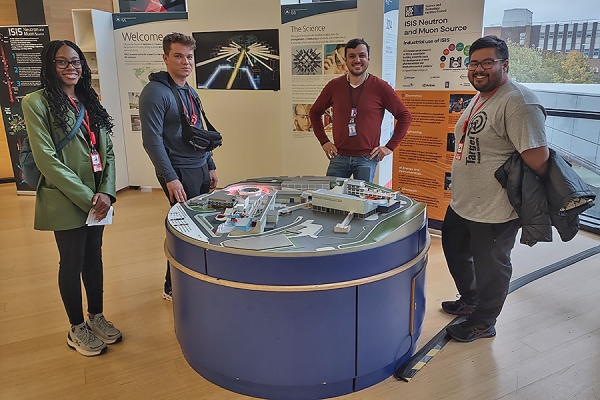 Mario Campana (third from left), a scientist at the ISIS Neutron and Muon Source, meets with UWindsor students Omotayo Gbadamosi, Maks Dziura, and Stuart Castillo at its facility in Oxfordshire, U.K.
Mario Campana (third from left), a scientist at the ISIS Neutron and Muon Source, meets with UWindsor students Omotayo Gbadamosi, Maks Dziura, and Stuart Castillo at its facility in Oxfordshire, U.K.
Drew Marquardt is travelling around the world trying to get Canadian researchers access to neutron scattering technology.
Neutron beams help analyze materials on the smallest scales to provide information that would be impossible to find out any other way. Canada’s last source of neutrons closed in 2018, and since then, Dr. Marquardt — acting head of the Department of Chemistry and Biochemistry — has been rustling up agreements and plans to get Canadian users access to highly coveted facilities.
“These activities will help the Canadian community overall,” he says.
Most recently, he was given a leadership role and asked to contribute to a United States Congress report. In late October, Marquardt, president of the Canadian Institute for Neutron Scattering, went to Washington, D.C. to chair a transition process panel to plan for a replacement reactor and accompanying facilities for the U.S. National Institute of Standards and Technology.
“As part of the recently passed CHIPS and Science act, the NIST Center for Neutron Research facility is leading a design and planning workshop for a new high-capacity scattering source,” Marquardt explains.
As part of the panel, Marquardt will write a section of the report detailing how to go from what currently exists to a new reactor in the least disruptive way possible.
“The output of my panel’s discussions will be compiled into a report to the U.S. Congress that will shape the plan for a new neutron source and accompanying facilities.”
After his stint in the United States, Marquardt will take a research project to the United Kingdom thanks to a recent collaborative agreement announced between the U.K.’s ISIS Neutron and Muon Source and Neutrons Canada. The partnership aims to open doors for the Canadian research community by providing enhanced access to U.K. neutron infrastructure.
“I’m proud of this agreement because the University of Windsor and I laid the groundwork to make this happen,” says Marquardt. “ISIS will give us access time as well as pay for travel costs for one student researcher per experiment.”
The deal also includes two stays of one month each for students to work at the facility.
On the home front, Marquardt is co-chairing the Canadian Neutron Long-Range Plan, a consultative process to develop a plan for implementation of the national neutron strategy during the next decade.
“This involves big questions such as what capabilities are necessary, what instruments do most Canadians use, and what areas need investment.”
The plan is critical for securing funding for the Canadian neutron beam community, because it will enable members to address funders, policy-makers, foreign partners, and others concerning its common needs.
—Sara Elliott
